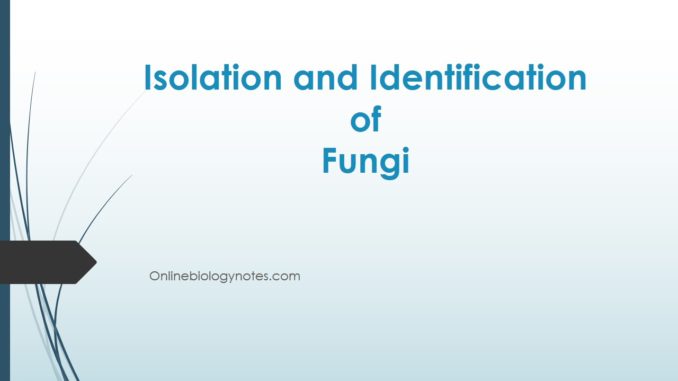
I. Method of Fungi isolation from soil
- Procedure:
- Sterile slide—> add the molten agar and allow to solidify —> cut the material making two half —-> place cover slip ——> seal the coverslip with wax or petroleum jelly making small area free at the side if cut —-> buried in a soil gently in a tray à allowed to incubate for few days ——-> remove gently ——> remove coverslip and observe under microscope.
- 1. Bait method:
- Many molds have quite specific nutrient requirements and are specialized to use materials that other fungi use with difficulty or not at all.
- We can isolate fungi by presenting a particular substance to the environment for colonization then later recovering it for isolation of the fungi that occupied it.
- Different types of baits might be pieces of wood, insects, carrot chunks, plastics, hair etc.
- The bait can be submerged in a specific habitat in nature or in a moist chamber.
- E.g. To isolate dermatophytes, we can place a hair on moist soil in a most chamber and examine it periodically for sporulating molds.
- Many cellulolytic fungi can be isolated from cellulose containing material.
- Then the mycelium is transferred into medium like PDA, SDA, Czapels agar for cultivation.
- Soil dilution plating:
- If hyphae cannot be dissected from field material for identification, they must be induced to grow cut as visible colonies onto an artificial culture medium.
- The dilution plate method, in which a dilution series is prepared from a soil suspension and the selected dilution incorporated in an agar medium (PDA-SDA).
- After few days of incubation, colonies will appear in varying densities and the number of spores present in the original sample can be calculated.
II. Method of isolation of fungi from Organic components:
- Fungi can also be isolated from rotten fruits, from roots etc.
- Surface sterilized —-> crushed in distilled water —–> inoculate in suitable agar medium.
III. Method of Fungi isolation from clinical specimens: Isolation of pathogenic Fungi
- Fungal cultures are microbiology laboratory tests to detect or role out the presence of fungi in specimens taken from patients or animals.
- The laboratory employs optimal conditions to grow and identify any fungus present in the specimen.
- The specimen is cultured on various agar media and then incubated and examined.
- Specimen could be the skin scrapping, nail scrapping, infected hair etc.
- Plate exposure method:
- Useful method for airborne fungi.
- Certain molds are likely to get their spores into the air and these spores may be serve as an infective agent of plant diseases and same allergies.
- These can be isolated by —> plate containing PDA is exposed to air for few minutes —-> covered à incubate at 25oC or room temperature for few days —-> observe.
- Imprint method:
- Fungi present on leaf surface or root of the plant can be isolated by pressing leaf or root on a suitable culture media and then incubate at 28oC or at room temperature.
- Other methods:
- Direct transfer, moist chamber, direct soil plate method etc.
Identification of fungi:
Methods of Identification of Fungi
1. Wet mount (tease mount) method for fungal hyphae identification:
- Procedure of wet mount preparation:
- Take a grease free slide and plate with fungus culture.
- With the help of sterile scalpel or 90o bent wire, remove fungal colonies from plate (which might contain a small amount of supporting agar.
- Place the portion of culture into a slide to which has been added to a drop of lactophenol cotton blue or aniline blue.
- Place the coverslip into position and apply the gentle pressure to dispose the general growth and agar.
- Examine microscopically.
- Drawbacks:
- Characteristic arrangement of spores might be disrupted when pressure is applied to the coverslip.
2. Adhesive (scotch) tape preparation for fungal spore identification:
- Procedure of scotch tape preparation:
- Touch the adhesive side of a cellophane tape to the surface of the colony.
- Adhere the tape to the surface of a microscopic slide to which has been added a drop of lactophenol cotton blue or aniline blue.
- For the characteristic shape and arrangement of the spores, microscopical examination is required.
- This method allows to observer in a way it sporulates in culture and easy method to identify organism.
- In instances where spores are not observed, a wet mount should be made as a backup step.
3. Microslide culture technique for fungi identification :
- Procedure of microslide culture technique:
- Take sterile petri dish—-> remove its lid —–> place sterile filter paper over it and add distilled water to moisten the filter paper —–> put glass slide over glass rod ——> add 5mm2 PDA agar on glass slide from agar plate ——> inoculate spores of fungi on that agar and cover with coverslip —–> incubate at room temperature for 7 days ——> remove coverslip and mounted in next slide and observe under microscope.
4. Coverslip culture technique for fungi identification :
- This technique is simple, less time-consuming technique which produces high quality permanent mounts and is suitable for clinical isolate identification, student teaching, examination of fungi at different stages of their development without disturbing the arrangement of spores and hyphal structure.
- It is advantageous over slide culture technique that if the first preparation fails to demonstrate adequate sporulation, there are still left to be examined of weekly intervals.
- The ability of aerial mycelia to adhere to a glass surface has been utilized as a basis of this technique.
- Procedure of coverslip culture method:
- Insert 4-5 coverslips on petri-plate containing POA at an angle of 45o —–> inoculate organism at the point of media and coverslip ——> incubate the plate at room temperature for 7 days ——> after incubation remove the coverslip gently and mounted with lactophenol cotton blue and observe under microscope.
